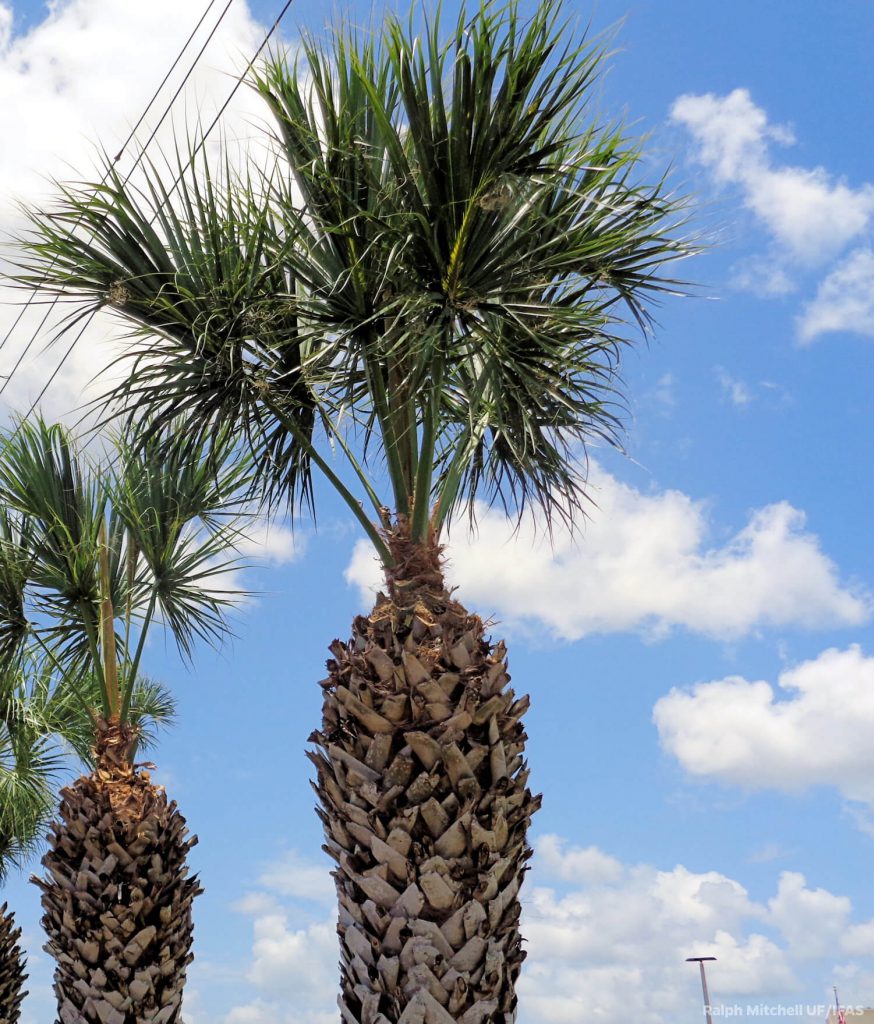
Before you start pruning any palms, please read ahead and consider the research-based, unbiased information offered. While there is really no mystery involved in properly pruning palms, I am still seeing these majestic plants being over-pruned and open to decline due to removing good, functioning fronds. While palm owners may be pruning for a certain look, palms are living things that may not be so easily molded for added convenience or abstract neatness. There is a method to the following palm pruning reasoning that will make sense in the end. Palms are key points of interest in our landscapes, are valuable, and take effort and many dollars to replace. Proper pruning will ensure a healthy palm for a good long time.
First, remember that some palms are “self-cleaning” and will shed old fronds all by themselves – no pruning necessary! As time marches on, palms are always replacing old, used-up fronds with new ones. In fact, a regular turnover of fronds is very normal and healthy. Palms actually maintain a certain number of functioning fronds at any given time. An excess number of yellow fronds may indicate a nutrient deficiency, but this should not trigger you to prune. Interestingly enough, palms will actually move nutrients from older leaves to newer leaves thus conserving essential resources. These leaves are the “solar panels” of the palm – food making and storage devises needed to keep the plant alive. Premature removal of good fronds unnecessarily weakens these plants which may predispose them to secondary problems.
What are some acceptable reasons for pruning a palm? Removing dead (or dying) fronds makes the palm look better and improves the overall appearance of the landscape. Dead fronds which are loosely attached to the palm may fall and injure people or damage property. Removing palm flower/fruit clusters is also fine – think about the impact of coconuts – literally! Timely removal also reduces the number of weedy palm seedlings (Queen palms for example) that could sprout up around the base.
Over-pruning can be detrimental to a palm. When a palm is subjected to a “hurricane cut”, it can develop a narrow trunk just below the fronds. This illegal and incorrect procedure also stresses the palm to a point where there is an increased chance of disease and insect invasion. Observations indicate that “hurricane-cut” palms actually appear more likely to be damaged in severe wind storms.
Your goal should be to remove only old, dead, brown fronds. However, if by chance you must remove a couple of green fronds that are rubbing up against a screen, follow this plan: “no leaves with tips above the horizontal plane (9:00 and 3:00 positions on a clock face) should be removed” – that is the line in the sand.
One last recommendation – make sure to use sterilized pruning tools to avoid transferring certain diseases from palm to palm. Palms are sensitive plants that often cannot tolerate excessive removal of their food making organs – their fronds. The resulting damage of unnecessary over-pruning is unattractive and can open up palms to future damage that may overwhelm the plant and cause it to die. Remember, your goal, if at all possible, is to remove only dead, brown fronds! For more information on all types of palm culture information, or to ask a question, please visit https://www.facebook.com/CharlotteMGLifeline/. Ralph E. Mitchell is the Director/Horticulture Agent for the UF/IFAS Charlotte County Extension Service. He can be reached at 941-764-4344 or ralph.mitchell@charlot tecountyfl.gov.
Resource:
Broschat, T. K. (2017) Pruning Palms. The University of Florida, IFAS.
 0
0
